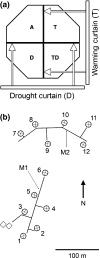A replicated climate change field experiment reveals rapid evolutionary response in an ecologically important soil invertebrate
- PMID: 27109012
- PMCID: PMC5021122
- DOI: 10.1111/gcb.13293
A replicated climate change field experiment reveals rapid evolutionary response in an ecologically important soil invertebrate
Abstract
Whether species can respond evolutionarily to current climate change is crucial for the persistence of many species. Yet, very few studies have examined genetic responses to climate change in manipulated experiments carried out in natural field conditions. We examined the evolutionary response to climate change in a common annelid worm using a controlled replicated experiment where climatic conditions were manipulated in a natural setting. Analyzing the transcribed genome of 15 local populations, we found that about 12% of the genetic polymorphisms exhibit differences in allele frequencies associated to changes in soil temperature and soil moisture. This shows an evolutionary response to realistic climate change happening over short-time scale, and calls for incorporating evolution into models predicting future response of species to climate change. It also shows that designed climate change experiments coupled with genome sequencing offer great potential to test for the occurrence (or lack) of an evolutionary response.
Keywords: RNA-seq; SNP; field experiment; selection.
© 2016 The Authors. Global Change Biology Published by John Wiley & Sons Ltd.
Figures





References
-
- Andresen LC, Konestabo HS, Maraldo K, Holmstrup M, Ambus P, Beier C, Michelsen A (2011) Organic matter flow in the food web at a temperate heath under multifactorial climate change. Rapid Communications in Mass Spectrometry, 25, 1485–1496. - PubMed
-
- Augustsson AK, Rundgren S (1998) The enchytraeid Cognettia sphagnetorum in risk assessment: advantages and disadvantages. Ambio, 27, 62–69.
-
- Balanyá J, Oller JM, Huey RB, Gilchrist GW, Serra L (2006) Global genetic change tracks global climate warming in Drosophila subobscura . Science, 313, 1773–1775. - PubMed
-
- Bierne N, Roze D, Welch JJ (2013) Pervasive selection or is it…? Why are FST outliers sometimes so frequent? Molecular Ecology, 22, 2061–2064. - PubMed
MeSH terms
Substances
LinkOut - more resources
Full Text Sources
Other Literature Sources
Medical

